SAAB 9-5 2000 User Guide
Manufacturer: SAAB, Model Year: 2000, Model line: 9-5, Model: SAAB 9-5 2000Pages: 256, PDF Size: 14.24 MB
Page 11 of 256
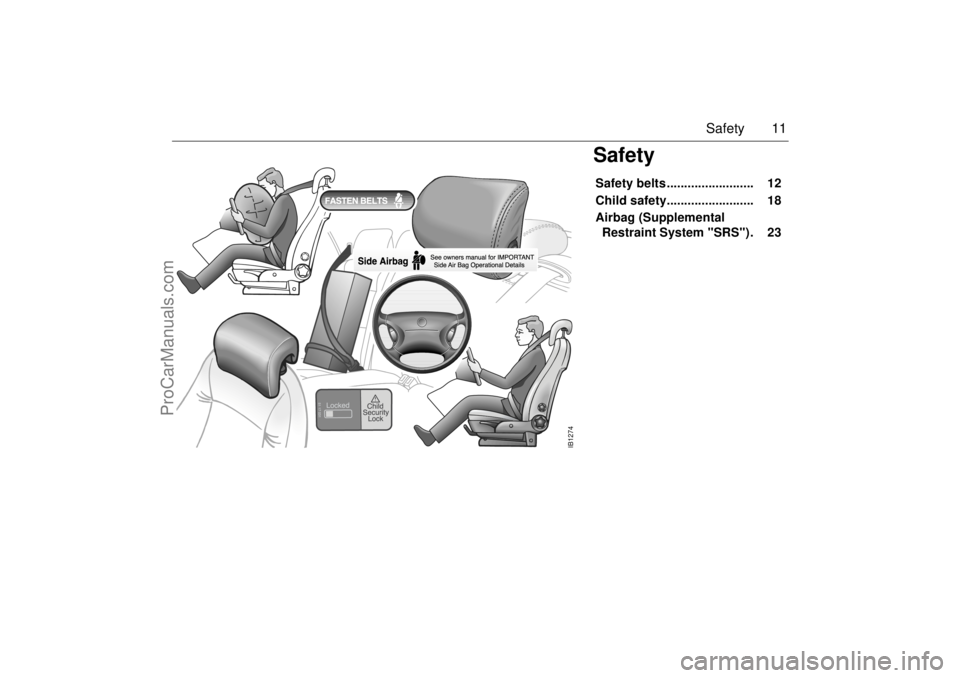
11 Safety
SafetySafety belts ......................... 12
Child safety......................... 18
Airbag (Supplemental
Restraint System "SRS"). 23
IB1274
ProCarManuals.com
Page 12 of 256
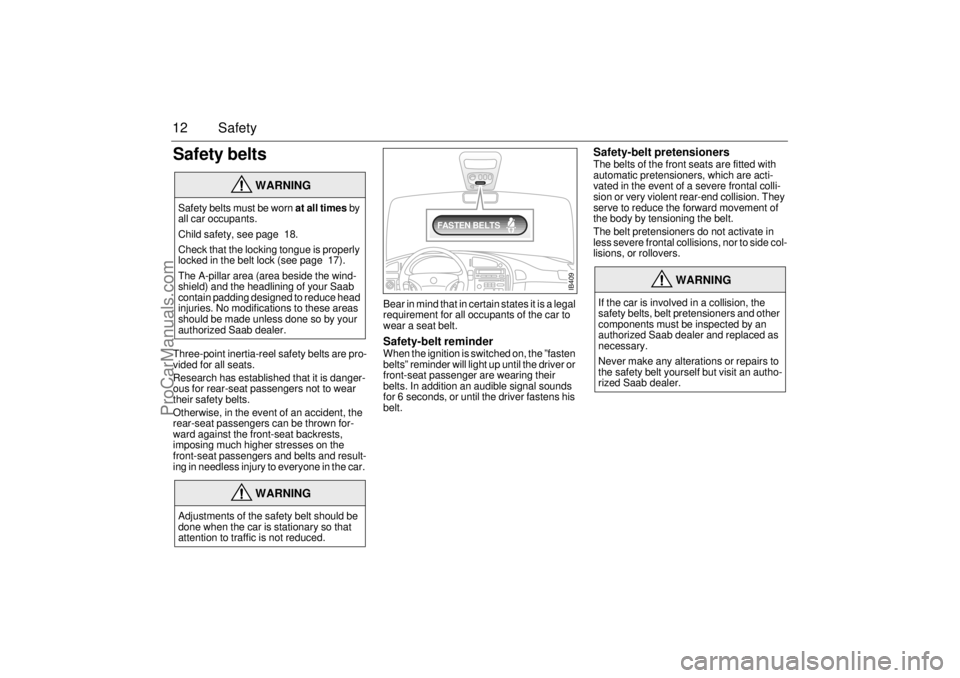
12 SafetySafety belts Three-point inertia-reel safety belts are pro-
vided for all seats.
Research has established that it is danger-
ous for rear-seat passengers not to wear
their safety belts.
Otherwise, in the event of an accident, the
rear-seat passengers can be thrown for-
ward against the front-seat backrests,
imposing much higher stresses on the
front-seat passengers and belts and result-
ing in needless injury to everyone in the car. Bear in mind that in certain states it is a legal
requirement for all occupants of the car to
wear a seat belt.
Safety-belt reminderWhen the ignition is switched on, the ”fasten
belts” reminder will light up until the driver or
front-seat passenger are wearing their
belts. In addition an audible signal sounds
for 6 seconds, or until the driver fastens his
belt.
Safety-belt pretensionersThe belts of the front seats are fitted with
automatic pretensioners, which are acti-
vated in the event of a severe frontal colli-
sion or very violent rear-end collision. They
serve to reduce the forward movement of
the body by tensioning the belt.
The belt pretensioners do not activate in
less severe frontal collisions, nor to side col-
lisions, or rollovers.
WARNING
Safety belts must be worn at all times by
all car occupants.
Child safety, see page 18.
Check that the locking tongue is properly
locked in the belt lock (see page 17).
The A-pillar area (area beside the wind-
shield) and the headlining of your Saab
contain padding designed to reduce head
injuries. No modifications to these areas
should be made unless done so by your
authorized Saab dealer.
WARNING
Adjustments of the safety belt should be
done when the car is stationary so that
attention to traffic is not reduced.
WARNING
If the car is involved in a collision, the
safety belts, belt pretensioners and other
components must be inspected by an
authorized Saab dealer and replaced as
necessary.
Never make any alterations or repairs to
the safety belt yourself but visit an autho-
rized Saab dealer.
IB409
FASTEN BELTS
ProCarManuals.com
Page 13 of 256
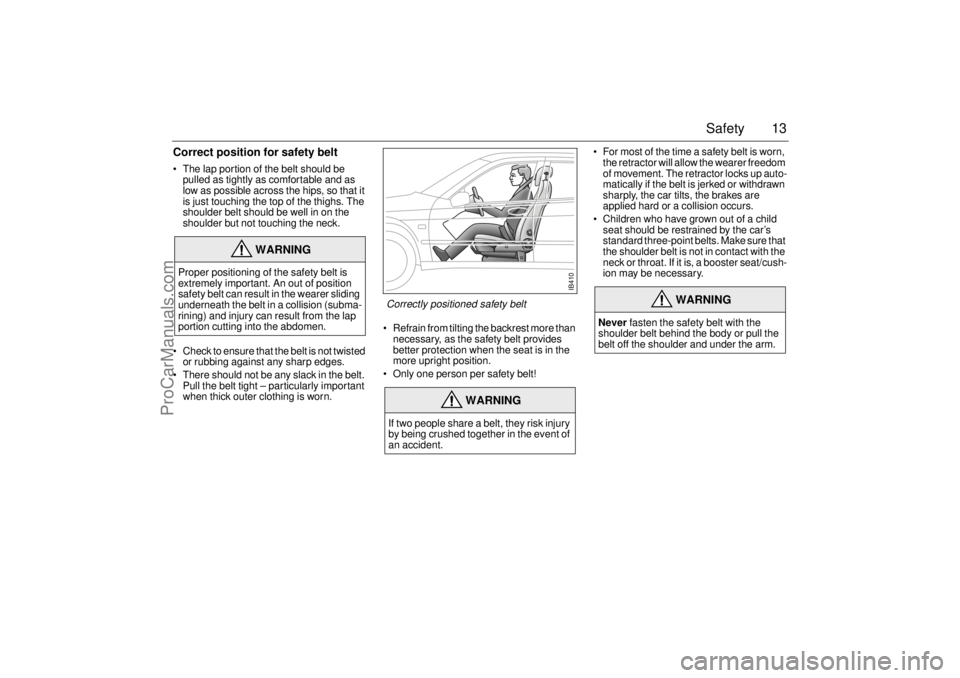
13 Safety
Correct position for safety belt The lap portion of the belt should be
pulled as tightly as comfortable and as
low as possible across the hips, so that it
is just touching the top of the thighs. The
shoulder belt should be well in on the
shoulder but not touching the neck.
Check to ensure that the belt is not twisted
or rubbing against any sharp edges.
There should not be any slack in the belt.
Pull the belt tight – particularly important
when thick outer clothing is worn. Refrain from tilting the backrest more than
necessary, as the safety belt provides
better protection when the seat is in the
more upright position.
Only one person per safety belt! For most of the time a safety belt is worn,
the retractor will allow the wearer freedom
of movement. The retractor locks up auto-
matically if the belt is jerked or withdrawn
sharply, the car tilts, the brakes are
applied hard or a collision occurs.
Children who have grown out of a child
seat should be restrained by the car’s
standard three-point belts. Make sure that
the shoulder belt is not in contact with the
neck or throat. If it is, a booster seat/cush-
ion may be necessary.
WARNING
Proper positioning of the safety belt is
extremely important. An out of position
safety belt can result in the wearer sliding
underneath the belt in a collision (subma-
rining) and injury can result from the lap
portion cutting into the abdomen.
WARNING
If two people share a belt, they risk injury
by being crushed together in the event of
an accident.
WARNING
Never fasten the safety belt with the
shoulder belt behind the body or pull the
belt off the shoulder and under the arm.
IB410
Correctly positioned safety belt
ProCarManuals.com
Page 14 of 256
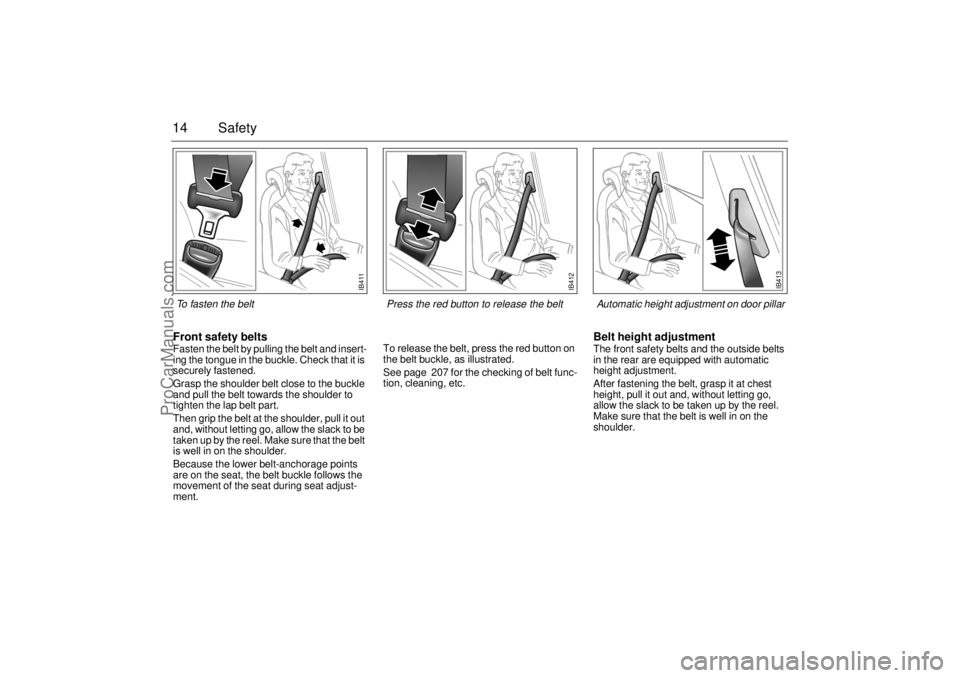
14 SafetyFront safety belts Fasten the belt by pulling the belt and insert-
ing the tongue in the buckle. Check that it is
securely fastened.
Grasp the shoulder belt close to the buckle
and pull the belt towards the shoulder to
tighten the lap belt part.
Then grip the belt at the shoulder, pull it out
and, without letting go, allow the slack to be
taken up by the reel. Make sure that the belt
is well in on the shoulder.
Because the lower belt-anchorage points
are on the seat, the belt buckle follows the
movement of the seat during seat adjust-
ment.To release the belt, press the red button on
the belt buckle, as illustrated.
See page 207 for the checking of belt func-
tion, cleaning, etc.
Belt height adjustmentThe front safety belts and the outside belts
in the rear are equipped with automatic
height adjustment.
After fastening the belt, grasp it at chest
height, pull it out and, without letting go,
allow the slack to be taken up by the reel.
Make sure that the belt is well in on the
shoulder.
IB411
To fasten the belt
IB412
Press the red button to release the belt
IB413
Automatic height adjustment on door pillar
ProCarManuals.com
Page 15 of 256
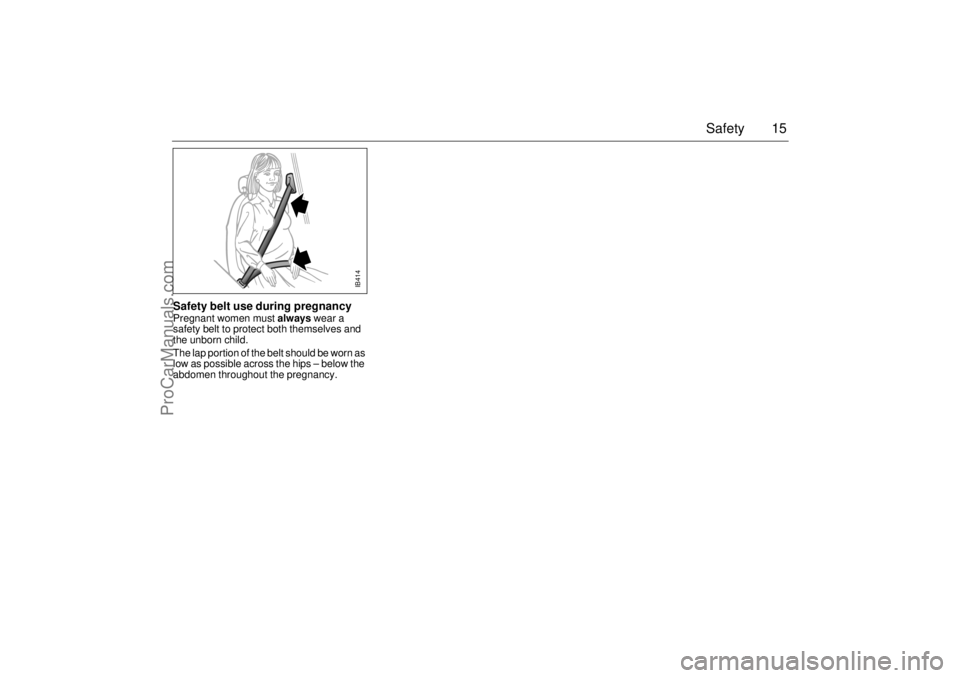
15 Safety
Safety belt use during pregnancyPregnant women must always wear a
safety belt to protect both themselves and
the unborn child.
The lap portion of the belt should be worn as
low as possible across the hips – below the
abdomen throughout the pregnancy.
IB414
ProCarManuals.com
Page 16 of 256
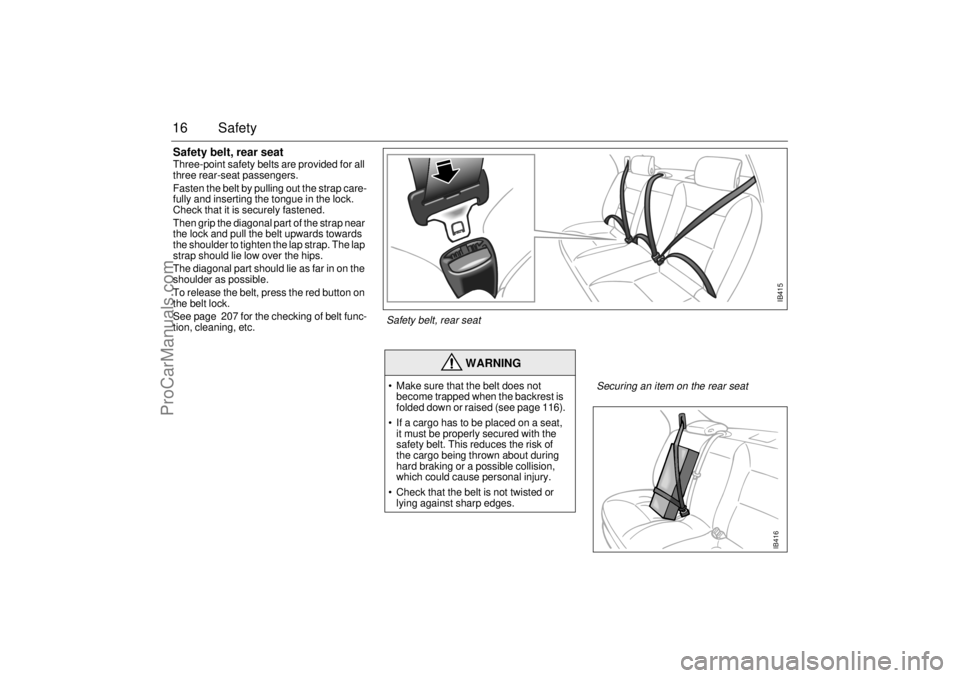
16 SafetySafety belt, rear seat Three-point safety belts are provided for all
three rear-seat passengers.
Fasten the belt by pulling out the strap care-
fully and inserting the tongue in the lock.
Check that it is securely fastened.
Then grip the diagonal part of the strap near
the lock and pull the belt upwards towards
the shoulder to tighten the lap strap. The lap
strap should lie low over the hips.
The diagonal part should lie as far in on the
shoulder as possible.
To release the belt, press the red button on
the belt lock.
See page 207 for the checking of belt func-
tion, cleaning, etc.
WARNING
Make sure that the belt does not
become trapped when the backrest is
folded down or raised (see page 116).
If a cargo has to be placed on a seat,
it must be properly secured with the
safety belt. This reduces the risk of
the cargo being thrown about during
hard braking or a possible collision,
which could cause personal injury.
Check that the belt is not twisted or
lying against sharp edges.
IB???IB415
Safety belt, rear seat
IB416
Securing an item on the rear seat
ProCarManuals.com
Page 17 of 256
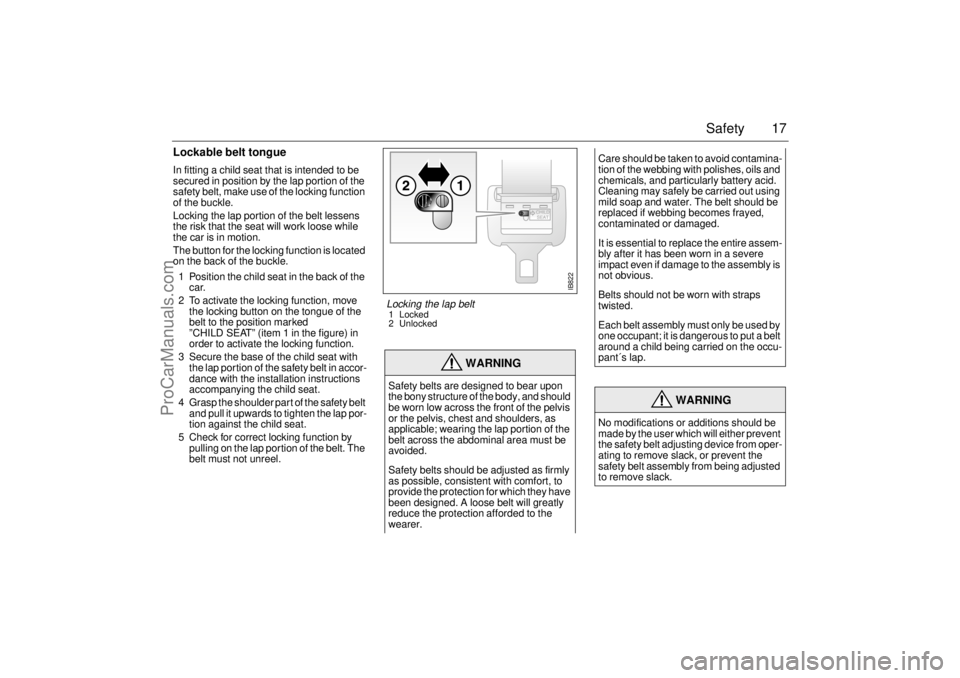
17 Safety
Lockable belt tongue In fitting a child seat that is intended to be
secured in position by the lap portion of the
safety belt, make use of the locking function
of the buckle.
Locking the lap portion of the belt lessens
the risk that the seat will work loose while
the car is in motion.
The button for the locking function is located
on the back of the buckle.
1 Position the child seat in the back of the
car.
2 To activate the locking function, move
the locking button on the tongue of the
belt to the position marked
”CHILD SEAT” (item 1 in the figure) in
order to activate the locking function.
3 Secure the base of the child seat with
the lap portion of the safety belt in accor-
dance with the installation instructions
accompanying the child seat.
4 Grasp the shoulder part of the safety belt
and pull it upwards to tighten the lap por-
tion against the child seat.
5 Check for correct locking function by
pulling on the lap portion of the belt. The
belt must not unreel.
WARNING
Safety belts are designed to bear upon
the bony structure of the body, and should
be worn low across the front of the pelvis
or the pelvis, chest and shoulders, as
applicable; wearing the lap portion of the
belt across the abdominal area must be
avoided.
Safety belts should be adjusted as firmly
as possible, consistent with comfort, to
provide the protection for which they have
been designed. A loose belt will greatly
reduce the protection afforded to the
wearer.
Care should be taken to avoid contamina-
tion of the webbing with polishes, oils and
chemicals, and particularly battery acid.
Cleaning may safely be carried out using
mild soap and water. The belt should be
replaced if webbing becomes frayed,
contaminated or damaged.
It is essential to replace the entire assem-
bly after it has been worn in a severe
impact even if damage to the assembly is
not obvious.
Belts should not be worn with straps
twisted.
Each belt assembly must only be used by
one occupant; it is dangerous to put a belt
around a child being carried on the occu-
pant´s lap.
WARNING
No modifications or additions should be
made by the user which will either prevent
the safety belt adjusting device from oper-
ating to remove slack, or prevent the
safety belt assembly from being adjusted
to remove slack.
IB822
Locking the lap belt1 Locked
2 Unlocked
ProCarManuals.com
Page 18 of 256
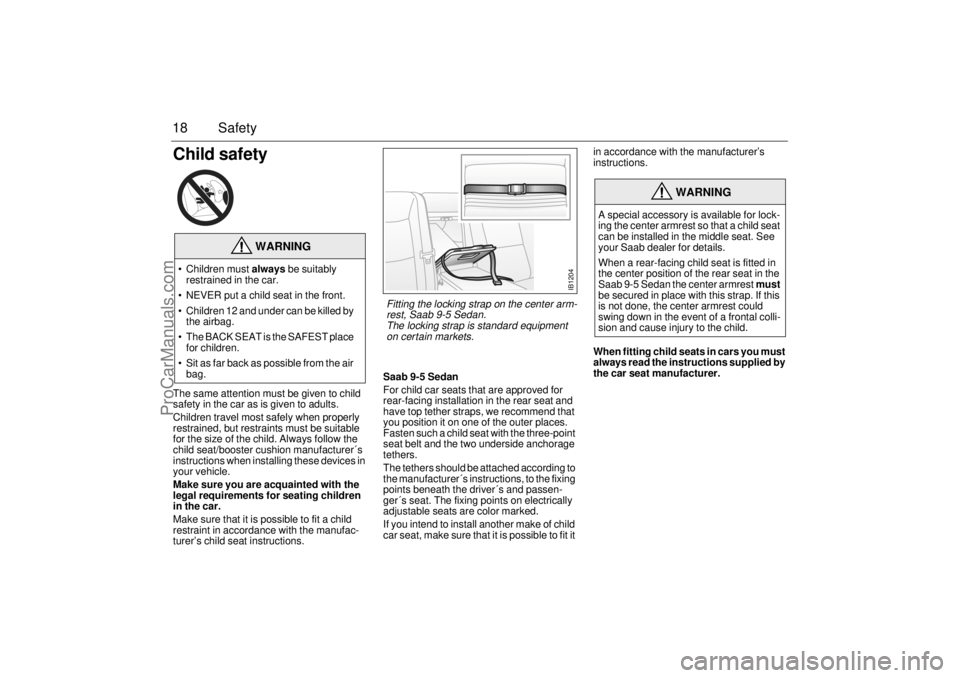
18 SafetyChild safety
The same attention must be given to child
safety in the car as is given to adults.
Children travel most safely when properly
restrained, but restraints must be suitable
for the size of the child. Always follow the
child seat/booster cushion manufacturer´s
instructions when installing these devices in
your vehicle.
Make sure you are acquainted with the
legal requirements for seating children
in the car.
Make sure that it is possible to fit a child
restraint in accordance with the manufac-
turer’s child seat instructions.Saab 9-5 Sedan
For child car seats that are approved for
rear-facing installation in the rear seat and
have top tether straps, we recommend that
you position it on one of the outer places.
Fasten such a child seat with the three-point
seat belt and the two underside anchorage
tethers.
The tethers should be attached according to
the manufacturer´s instructions, to the fixing
points beneath the driver´s and passen-
ger´s seat. The fixing points on electrically
adjustable seats are color marked.
If you intend to install another make of child
car seat, make sure that it is possible to fit it in accordance with the manufacturer’s
instructions.
When fitting child seats in cars you must
always read the instructions supplied by
the car seat manufacturer.
WARNING
Children must always be suitably
restrained in the car.
NEVER put a child seat in the front.
Children 12 and under can be killed by
the airbag.
The BACK SEAT is the SAFEST place
for children.
Sit as far back as possible from the air
bag.
WARNING
A special accessory is available for lock-
ing the center armrest so that a child seat
can be installed in the middle seat. See
your Saab dealer for details.
When a rear-facing child seat is fitted in
the center position of the rear seat in the
Saab 9-5 Sedan the center armrest must
be secured in place with this strap. If this
is not done, the center armrest could
swing down in the event of a frontal colli-
sion and cause injury to the child.
IB1204
Fitting the locking strap on the center arm-
rest, Saab 9-5 Sedan.
The locking strap is standard equipment
on certain markets.
ProCarManuals.com
Page 19 of 256
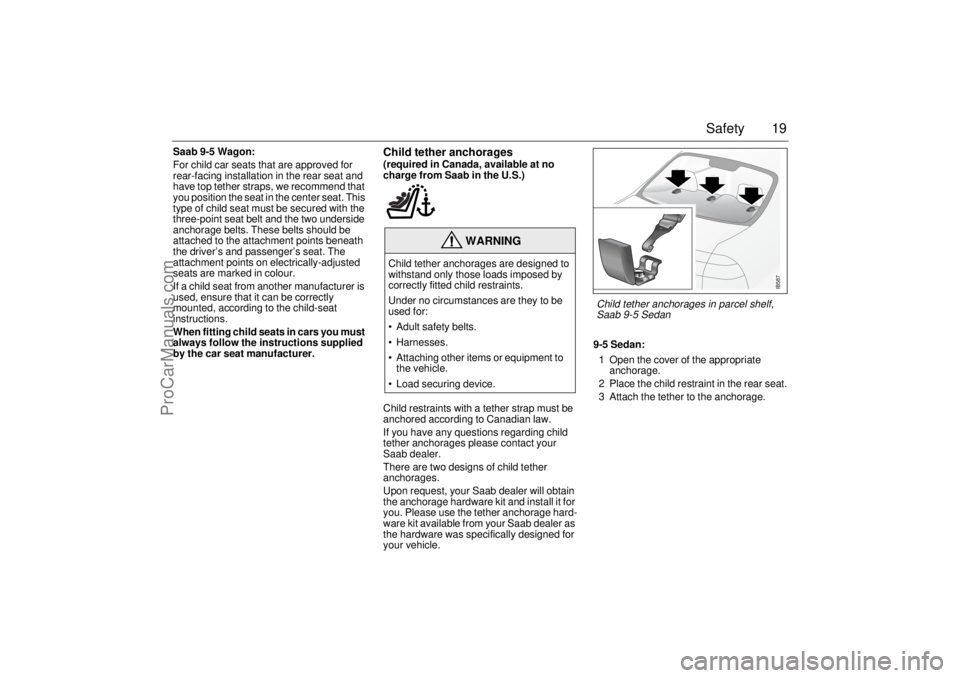
19 Safety
Saab 9-5 Wagon:
For child car seats that are approved for
rear-facing installation in the rear seat and
have top tether straps, we recommend that
you position the seat in the center seat. This
type of child seat must be secured with the
three-point seat belt and the two underside
anchorage belts. These belts should be
attached to the attachment points beneath
the driver’s and passenger’s seat. The
attachment points on electrically-adjusted
seats are marked in colour.
If a child seat from another manufacturer is
used, ensure that it can be correctly
mounted, according to the child-seat
instructions.
When fitting child seats in cars you must
always follow the instructions supplied
by the car seat manufacturer.
Child tether anchorages(required in Canada, available at no
charge from Saab in the U.S.)
Child restraints with a tether strap must be
anchored according to Canadian law.
If you have any questions regarding child
tether anchorages please contact your
Saab dealer.
There are two designs of child tether
anchorages.
Upon request, your Saab dealer will obtain
the anchorage hardware kit and install it for
you. Please use the tether anchorage hard-
ware kit available from your Saab dealer as
the hardware was specifically designed for
your vehicle.9-5 Sedan:
1 Open the cover of the appropriate
anchorage.
2 Place the child restraint in the rear seat.
3 Attach the tether to the anchorage.
WARNING
Child tether anchorages are designed to
withstand only those loads imposed by
correctly fitted child restraints.
Under no circumstances are they to be
used for:
Adult safety belts.
Harnesses.
Attaching other items or equipment to
the vehicle.
Load securing device.
IB587
Child tether anchorages in parcel shelf,
Saab 9-5 Sedan
ProCarManuals.com
Page 20 of 256
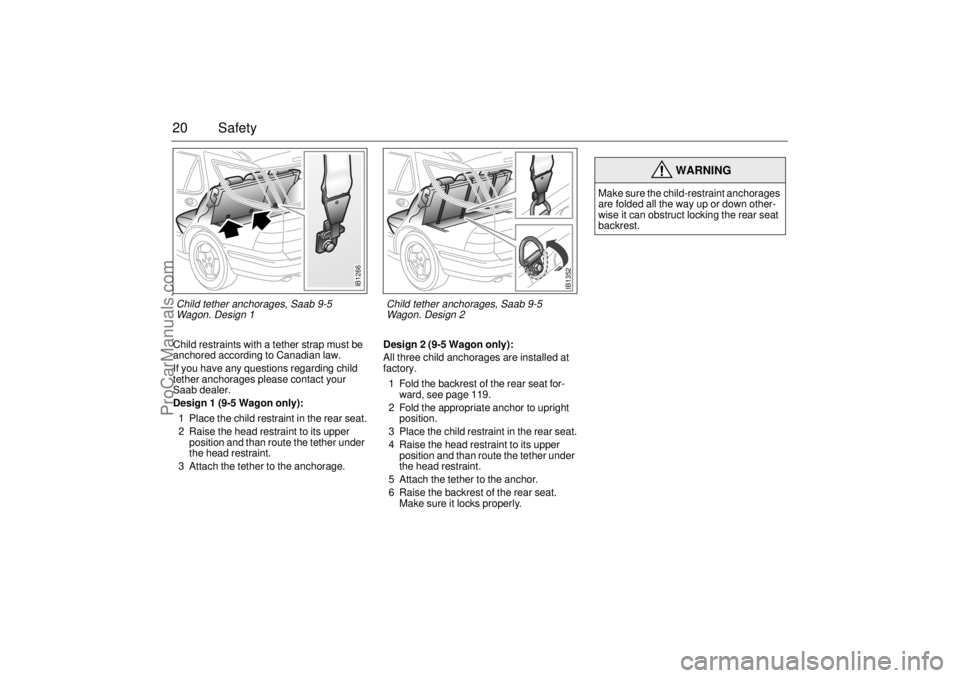
20 SafetyChild restraints with a tether strap must be
anchored according to Canadian law.
If you have any questions regarding child
tether anchorages please contact your
Saab dealer.
Design 1 (9-5 Wagon only):
1 Place the child restraint in the rear seat.
2 Raise the head restraint to its upper
position and than route the tether under
the head restraint.
3 Attach the tether to the anchorage.Design 2 (9-5 Wagon only):
All three child anchorages are installed at
factory.
1 Fold the backrest of the rear seat for-
ward, see page 119.
2 Fold the appropriate anchor to upright
position.
3 Place the child restraint in the rear seat.
4 Raise the head restraint to its upper
position and than route the tether under
the head restraint.
5 Attach the tether to the anchor.
6 Raise the backrest of the rear seat.
Make sure it locks properly.
WARNING
Make sure the child-restraint anchorages
are folded all the way up or down other-
wise it can obstruct locking the rear seat
backrest.
IB1266
Child tether anchorages, Saab 9-5
Wagon. Design 1
IB1352
Child tether anchorages, Saab 9-5
Wagon. Design 2
ProCarManuals.com